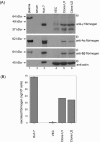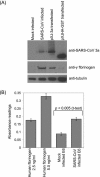The severe acute respiratory syndrome coronavirus 3a protein up-regulates expression of fibrinogen in lung epithelial cells
- PMID: 16014971
- PMCID: PMC1181587
- DOI: 10.1128/JVI.79.15.10083-10087.2005
The severe acute respiratory syndrome coronavirus 3a protein up-regulates expression of fibrinogen in lung epithelial cells
Abstract
Here we analyzed the gene expression profile of cells that stably express the severe acute respiratory syndrome coronavirus (SARS-CoV) 3a protein to determine its effects on host functions. A lung epithelial cell-line, A549, was chosen for this study because the lung is the primary organ infected by SARS-CoV and fatalities resulted mainly from pulmonary complications. Our results showed that the expression of 3a up-regulates the mRNA levels of all three subunits, Aalpha, Bbeta, and gamma, of fibrinogen. Consequently, the intracellular levels as well as the secretion of fibrinogen were increased. We also observed increased fibrinogen levels in SARS-CoV-infected Vero E6 cells.
Figures



Similar articles
-
The 3a protein of severe acute respiratory syndrome-associated coronavirus induces apoptosis in Vero E6 cells.J Gen Virol. 2005 Jul;86(Pt 7):1921-1930. doi: 10.1099/vir.0.80813-0. J Gen Virol. 2005. PMID: 15958670
-
Characterization of the 3a protein of SARS-associated coronavirus in infected vero E6 cells and SARS patients.J Mol Biol. 2004 Jul 30;341(1):271-9. doi: 10.1016/j.jmb.2004.06.016. J Mol Biol. 2004. PMID: 15312778 Free PMC article.
-
Identification of a novel protein 3a from severe acute respiratory syndrome coronavirus.FEBS Lett. 2004 May 7;565(1-3):111-6. doi: 10.1016/j.febslet.2004.03.086. FEBS Lett. 2004. PMID: 15135062 Free PMC article.
-
Expression of the severe acute respiratory syndrome coronavirus 3a protein and the assembly of coronavirus-like particles in the baculovirus expression system.Methods Mol Biol. 2007;379:35-50. doi: 10.1007/978-1-59745-393-6_3. Methods Mol Biol. 2007. PMID: 17502669 Free PMC article. Review.
-
Coronavirus Proteins as Ion Channels: Current and Potential Research.Front Immunol. 2020 Oct 9;11:573339. doi: 10.3389/fimmu.2020.573339. eCollection 2020. Front Immunol. 2020. PMID: 33154751 Free PMC article. Review.
Cited by
-
Severe acute respiratory syndrome coronavirus as an agent of emerging and reemerging infection.Clin Microbiol Rev. 2007 Oct;20(4):660-94. doi: 10.1128/CMR.00023-07. Clin Microbiol Rev. 2007. PMID: 17934078 Free PMC article. Review.
-
Beyond Channel Activity: Protein-Protein Interactions Involving Viroporins.Subcell Biochem. 2018;88:329-377. doi: 10.1007/978-981-10-8456-0_15. Subcell Biochem. 2018. PMID: 29900504 Free PMC article. Review.
-
Structure and Function of Major SARS-CoV-2 and SARS-CoV Proteins.Bioinform Biol Insights. 2021 Jun 22;15:11779322211025876. doi: 10.1177/11779322211025876. eCollection 2021. Bioinform Biol Insights. 2021. PMID: 34220199 Free PMC article. Review.
-
Biochemical and antigenic characterization of the structural proteins and their post-translational modifications in purified SARS-CoV-2 virions of an inactivated vaccine candidate.Emerg Microbes Infect. 2020 Dec;9(1):2653-2662. doi: 10.1080/22221751.2020.1855945. Emerg Microbes Infect. 2020. PMID: 33232205 Free PMC article.
-
Accessory proteins of SARS-CoV and other coronaviruses.Antiviral Res. 2014 Sep;109:97-109. doi: 10.1016/j.antiviral.2014.06.013. Epub 2014 Jul 1. Antiviral Res. 2014. PMID: 24995382 Free PMC article. Review.
References
-
- Bini, A., P. J. Simpson-Haidaris, and B. J. Kudryk. 2000. Fibrin/fibrinogen, p. 372. In A. Bikfalvi (ed.), Encyclopedic reference of vascular biology & pathology. Springer-Verlag, Berlin, Germany.
-
- Chong, P. Y., P. Chui, A. E. Ling, T. J. Franks, D. Y. Tai, Y. S. Leo, G. J. Kaw, G. Wansaicheong, K. P. Chan, L. L. Ean Oon, E. S. Teo, K. B. Tan, N. Nakajima, T. Sata, and W. D. Travis. 2004. Analysis of deaths during the severe acute respiratory syndrome (SARS) epidemic in Singapore: challenges in determining a SARS diagnosis. Arch. Pathol. Lab. Med. 128:195-204. - PubMed
-
- Clark, R. A. F. 1996. Wound repair, p. 617. In R. A. F. Clark (ed.), The molecular and cellular biology of wound repair. Plenum Press, New York, N.Y.
-
- Dowton, S. B., and H. R. Colten. 1988. Acute phase reactants in inflammation and infection. Semin. Hematol. 25:84-90. - PubMed
Publication types
MeSH terms
Substances
LinkOut - more resources
Full Text Sources
Other Literature Sources
Molecular Biology Databases
Miscellaneous

